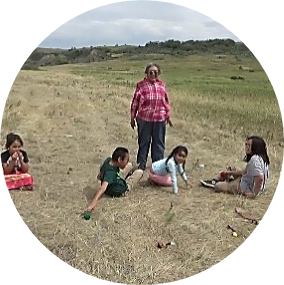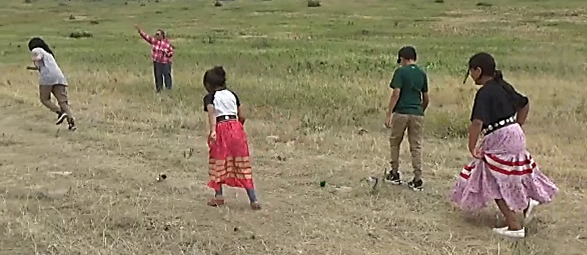Indigenous Ball Games
Pokón Iihtá’paisskootsiiyo’p
With Mary Ellen Little Mustache
Many of the games that are played today come from traditional Indigenous games. Games like soccer, basketball, shinney or hockey, and kickball (Little Mustache, 2023). There were many variations of ball games for ball racing over the prairies. Because there are many gopher holes, a tail was and is still often attached to be able to retrieve balls after falling through holes (Wilson, 2020).
In the past, ball games consisted of various activities using a ball that was usually made of stuffed buckskin; some were wooden, or made from bladder, cordage, bone, or sinew (Stewart, 1992). Unless the game rules included the use of hands, touching the ball with hands in any ball game was a strictly forbidden rule (Stewart, 1992).
The ball race was popular among the Southwest tribes and consisted of players kicking or tossing balls with their feet around a circuit that comes back to the beginning. Some tribes would set up two posts at the end of the track with relay stations along the track for additional players to aid in moving the ball along for their team. Similar to soccer today, the goal was to kick the ball between the two posts and winners were the first ones through the posts. As with many contests of games, there would be stakeholders and bets placed on teams. A medicine man would accompany the team with advice for food and water consumption (Stewart, 1992).
The overhead ball throw, or sling ball, requires players to pinch the ball between the large toe of each foot while sitting on the ground. Each player would have to roll back, swing their legs up over their heads with the ball between their toes and throw it as far as they could. The one who could throw it the farthest was the winner. (Little Mustache, 2023). The Northern Cheyenne used to pinch the tail on the ball and throw it overhead. It is called Sling Ball and played to build core strength (IPLA, 2014).
Some ball games used rackets, such as in lacrosse. This is generally a game men played, but many tribes included women’s games as well as, co-ed games. Balls were often juggled, and players practiced handling them with sticks to enhance skills (Stewart, 1992).
Double ball
The ball is made up of two oblong balls made from buckskin and stuffed with buffalo hair or deer hair that are connected by a long thong. Players try to ring the double ball with their sticks.
Traditionally, double ball was called the “Throwing Game” by women who try to throw the ball around their opponents’ pole. The poles are placed at opposite ends of the playing field. Two teams start at each end of the field with each player holding a long stick. At the whistle, players run for the double ball placed in the middle of the field and runs to sling it around the pole (High Five, 2020).
In indigenous culture, adults held the responsibility of hunting, fishing, and procuring various foods for their clans, while children would play games every day to develop their skills for these upcoming responsibilities. Children also learn skills of balance, motor and cognitive coordination, agility, reflexes, and patience while playing various games. These skills were mastered to become a reliable provider for community roles (Indigenous Corporate Training, 2019).
References
Little Mustache, M.E. (2023). In discussion July 2023.
Wilson, Cole. Indigenous Games Handout. Retrieved online June, 2020 speaonline.ca/uploads/3/8/2/9/38299825/indiginous_games_handout.
Stewart, C. (1992). Games of the North American Indians. Vol. 2 (pg. 561,562; 665, 666, 670).
International Physical Literacy Association (2014). Move and play through traditional games. Retrieved online 2020 from: Move Play Through Traditional Games Lesson Plan Grade 4 Social May 29 18 Updated | PDF | Métis | First Nations (scribd.com).
High Five (2020). Indigenous games for children. Retrieved online 2020 from www.highfive.org.
Indigenous Corporate Training. (2019). The role of indigenous games in culture. Retrieved online September, 2023 from The Role of Indigenous Games in Culture (ictinc.ca).
For more information of how ball games improve cognitive tasks see Indigenous Resources at BBT.





